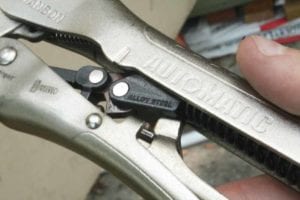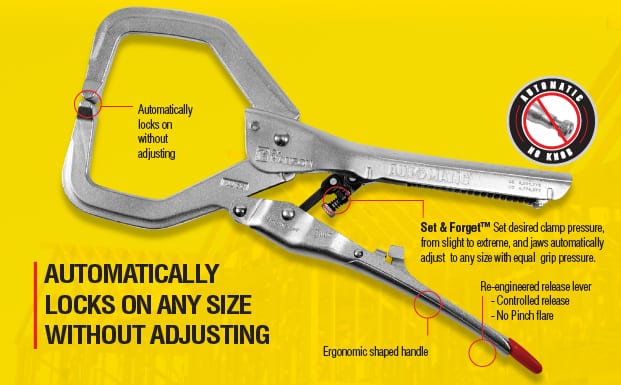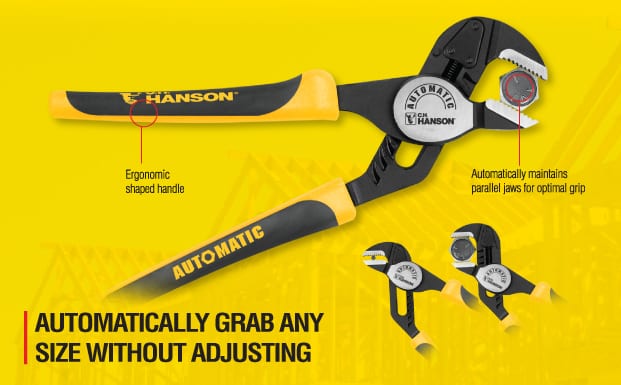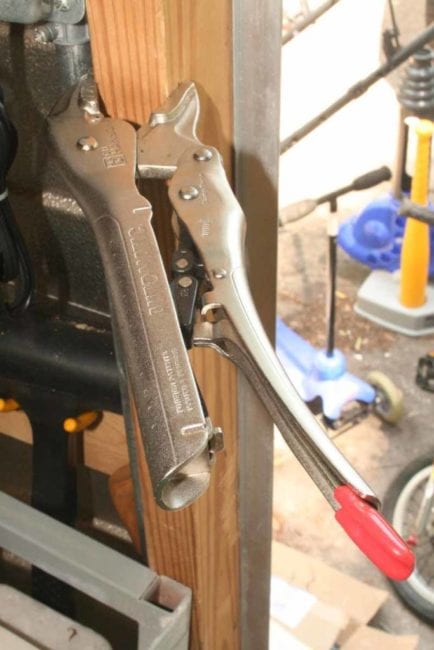Is the standard Vice Grip pliers dead? C.H. Hanson seems to think so with the invention of their new C.H. Hanson Automatic Locking Pliers. It revolutionizes the locking pliers and gives the tool new life and a much quicker grip. The company designed the pliers to directly take on the standard Vice Grip locking pliers and be faster and more usable. In fact, the company touts that the new tool can be used one-handed in many cases. Could this be the end of an era for locking pliers? Perhaps – that is, if you can find a pair of C. H. Hanson Automatic Locking Pliers. We looked all over and they a bit hard to find and handle in person.
C.H. Hanson Automatic Locking Pliers Features
Build Quality
The C.H. Hanson Automatic Locking Pliers are built from Chrome molybdenum steel, a hard steel alloy used in many tools and aviation applications. You may have heard it referred to as “Chromoly Steel”. That’s hard stuff, though not uncommon. Upon first look there’s no real difference from these pliers and a standard pair of locking pliers until you get to the guts. Then it hits you: Where’s the jaw size adjustment screw? Well, the automatic locking pliers use an advanced mechanism to eliminate the need for setting the jaws. In fact, the only adjustment is the locking strength, which is configured by the turning of a tension screw that is accessible when the handle is opened.
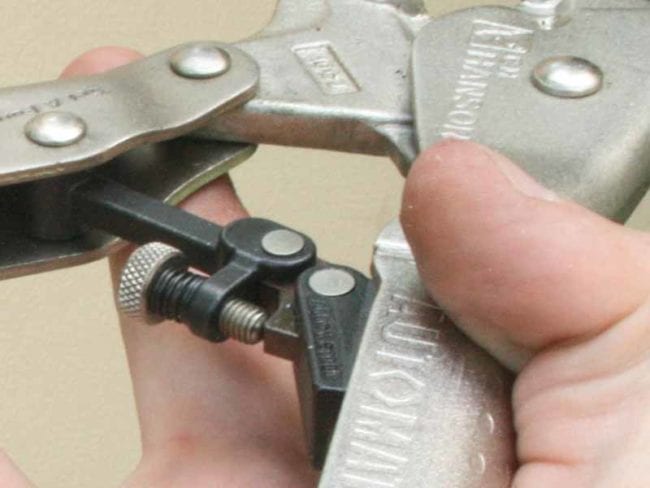
The pliers are available in numerous models. In this series, there are four versions:
- 6″ Curved Jaw (06100)
- 7″ Needle Nose (09300)
- 10″ Curved Jaw (10100) – the review model
- 10″ Straight Jaw (10110)
Now, aside from these four models, there are also 9 models of Locking Clamps. These clamps use the same mechanism as the locking pliers, but allow a more robust application to quickly and securely hold wood together, or secure just about anything you happen to be working on in the shop or at the jobsite.
Something that really impressed us was the brilliance of the lever system used to release the handle. Instead of a pinch-release, common on traditional Vice Grips for example, the C. H. Hanson Automatic Locking Pliers feature a squeezable trigger lever. That means you can literally grab the tool one-handed and use your ring finger to release it from its grip. Now you may have to use two hands if you have the tension set exceptionally tight – but gone is that finger-pinching mechanism that has given me and everyone I know more than a few red marks in the past.
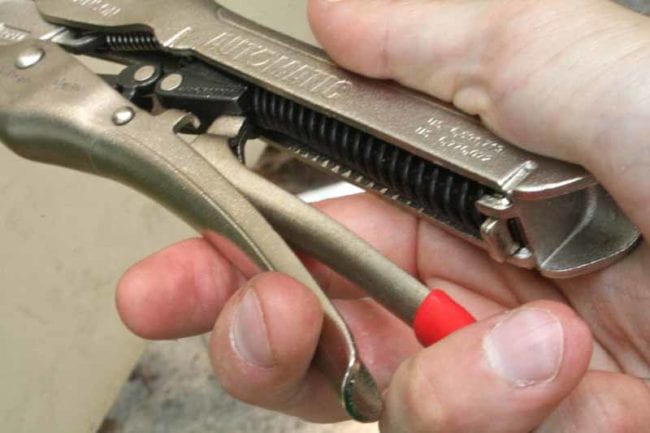
Testing and Use
How exactly would one review a pair of Automatic Locking Pliers/ Well, for starters I could immediately see how much faster they would be to use. But how much faster? I decided to pull out my trusty stopwatch…er, app, and find out. I did several tests. One was on an included pair of bolts welded to a sheet of steel plate that C. H. Hanson sent me (along with a cheap plastic stopwatch that didn’t actually work as a stopwatch – much to my amusement). The test was simple: clamp and unclamp all three objects starting with the sheet metal. I started with both locking pliers in a fully closed position. For the Irwin Vice Grips, this meant that I would adjust the set screw down until the jaws were completely together. The C.H. Hanson Automatic Locking Pliers automatically close all the way when you squeeze the handle.
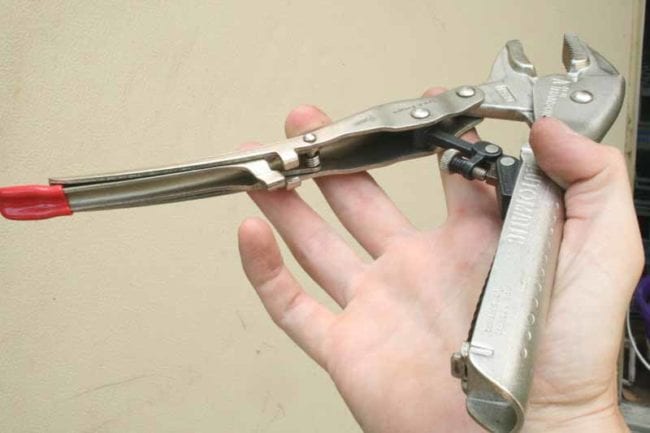
After running the test a few times, I found that I could clamp all three objects in 50.7 seconds with the Irwin locking pliers. After some practice this time didn’t get a ton shorter – at least not with the way I was running it. The locking pliers did the job (once I got used to them) in just 24.1 seconds, one-handed. Using two hands I could get the time down to around 14.2 seconds. There was really no way to speed up the Irwin test. Repeating the testing on other objects, I found that most of the time I could accomplish the same tasks in at least half the time. Many times I could do it in a third. That’s a bit less than C. H. Hanson’s touted “7x faster” number, but I’m certain I could find some sort of test that would bear that out. All I’d need to do was bounce back and forth a few times between very thin and very thick applications. Adjusting the set screw vs. simply re-attaching the pliers is what occupies the bulk of the time.
Beyond the added speed, I simply enjoyed using the C.H. Hanson Automatic Locking Pliers. They make more sense as a hand tool. This goes triple for the release lever, which is as impressive to me as when Arrow and various companies started pioneering staplers that used spring-loaded firing mechanisms to generate more power with less up-front energy. When it comes to the Automatic Locking Pliers, the whole tool is impressive. About the only thing that detracts from the system is the need for the pliers to open up almost 90 degrees before the jaws are ready to clamp back onto something large. This took it away from being a one-handed tool and really forced you to grab it with both and get it set – unless you have gigantic hands, which I don’t.
Conclusion
The thing is, with little exception, this feels like the way a pair of locking pliers should work. C. H. Hanson has made a stable tool that feels good in the hand, is well-built, and has what looks to be a reliable, solid, and functional mechanism that revolutionizes the locking pliers. I’d like to say “it’s about time,” but to be honest, I didn’t know what I was missing. I think the end result is that the automatic pliers are going to make us all use them a lot more. And why not? They’ll be all that much easier to lock on and remove. For performance we had no choice but to give them a 9/10, docking them only because of the wide opening required for releasing the jaws. For Value, they get a 7/10 because at very little premium C. H. Hanson offers a new, compelling way to use a locking pliers.
About C. H. Hanson
C. H. Hanson offers more than 1,000 different products, both stock and custom, in more than 8 categories. We offer a complete line of marking and identification, chalk, cutting, layout, safety, and other non-powered hand tool products designed for use in the industrial, construction, safety, and hardware/DIY consumer markets.


